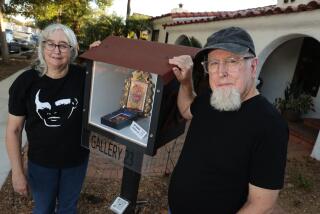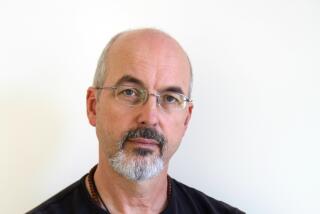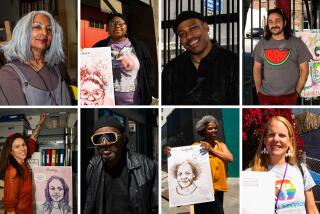An Artist’s Project Videotapes the Many Faces of Love
- Share via
Everything in life gets talked about when you talk about love .
--Artist Wendy Clarke
“My real awareness of love started when I gave birth to my first child,” Linda Wolf said, cradling her 17-month-old daughter.
“It isn’t love making the world go ‘round, it’s hate and chauvinism and prejudice,” said a morose, gray-haired Sarah Gilbert.
“I just had a long relationship end,” Gerry Rose said sadly. “It was sort of a dance that went wrong.”
These declarations were made on video by recent visitors to the USC Atelier. Spontaneously talking about love, each one recorded a three-minute monologue for “Love Tapes,” an exhibit engineered by artist Wendy Clarke.
“It’s fascinating,” Wolf said just after finishing her tape.
Remarked Eugenia Butler, about to make her second one: “Love is what art is all about.”
Like Wolf and Butler, gallery-goers make the free tapes by selecting a backdrop (red hearts, leopard skin, the wilderness), choosing music (“Natural Woman,” “Moonlight Sonata,” Cajun zydeco) and talking to the camera in a 10-by-10 cubicle. Then, with participants’ consent, the tapes are immediately screened for all to see.
“I’m interested in using video as a tool that affects us and enables us to have experiences that wouldn’t be possible otherwise,” said Clarke, whose “love tapes” have been shown at New York’s Museum of Modern Art and on nationwide television.
And it’s by seeing themselves on tape, watching strangers’ reactions to their own candid performances, and hearing others’ intimate disclosures, that “love tape” makers often are deeply affected, Clarke said.
“People have talked about being abused, about not experiencing love or the pain of romantic love,” she said. “But it’s cathartic and they feel better having shared it and often feel they’re helping others.
“And they do. It gives others the permission to express their feelings. Also, many people say it’s a pivotal experience for them. They feel like they’re not so isolated and different--that we are all really just human.”
After producing about 1,500 tapes since 1977, made by a broad range of people from college co-eds to unacculturated Latin American male immigrants, the Venice-based artist said she feels the same way.
“Seeing people I thought were different from me--old people, foreigners, the physically disabled--has enormously molded my own views about love and helped me to see we’re all the same species,” she said.
Clarke’s love tapes evolved from a class she took at Sarah Lawrence College in New York in 1969. Her teacher, Shirley Kaplan, taught students to create plays and dance compositions from videos in which they expressed their feelings about everyday experiences. (Also influential was dancer-choreographer-author-artist Remy Charlip, whose highly personal works often stem from written journals.)
After the class, “I’d been keeping a video journal where I’d sit by myself, look at myself, and talk about my feelings,” Clarke said. “It was a such a wonderful growth process for me that I tried to come up with a way to share it.”
Indeed, what’s paramount to her about the love tapes, Clarke said, is audience interaction.
“People come in and they are all terrified. Then they walk away having had this interesting experience. For me, creating art that’s an experience for people is the bottom line.”
Clarke, who has also made love tapes in France, Brazil, Japan, Germany and Holland, said that her long-range goal is to use them as a tool for global unity.
“It would really be amazing for conflict resolution,” she said. “Like showing the Arabs to the Israelis and Soviet citizens to U.S. citizens. When people talk about love--such a basic human experience--it can really break down those barriers of prejudice.”
Clarke will be at the USC Atelier, in the Santa Monica Place shopping mall, to supervise “Love Tape” production through Sunday. Hours are Tuesday-Sunday, noon-6 p.m.; Friday, noon-9 p.m. Reservations to make tapes: (213) 394-7373. After the exhibit, the tapes will be circulated by the Santa Monica Library and may be seen by appointment at the Long Beach Museum of Art.
More to Read
The biggest entertainment stories
Get our big stories about Hollywood, film, television, music, arts, culture and more right in your inbox as soon as they publish.
You may occasionally receive promotional content from the Los Angeles Times.










